In modern football, goalkeepers are typically responsible for taking goal-kicks, utilising their long-range kicking abilities to initiate attacks from the back. However, there are instances when defenders take on this role, introducing a tactical variation to a team’s playing style.
This data analysis aims to explore the dynamics and strategic implications of defenders taking goal-kicks. By examining the advantages, drawbacks, and impact on gameplay, we will delve into the reasons behind this decision, the potential benefits it offers, and the challenges it presents. Understanding the role of defenders in goal-kicks provides valuable insights into how teams can maximise their possession, exploit opposing tactics, and create opportunities for effective build-up play.
Also in this analysis, we will discover why the goal-kick taken by defenders is a trend led by the tactics of clubs in Italian Serie A.
Why defenders take goal-kicks
One of the primary reasons for a defender to take a goal-kick is to exploit the opposing team’s pressing tactics. If the opposition tends to press high and aggressively, the goalkeeper may opt to distribute the ball quickly to a defender positioned near the corner of the penalty box. This allows the team to bypass the initial press and initiate an attacking move from a different angle.
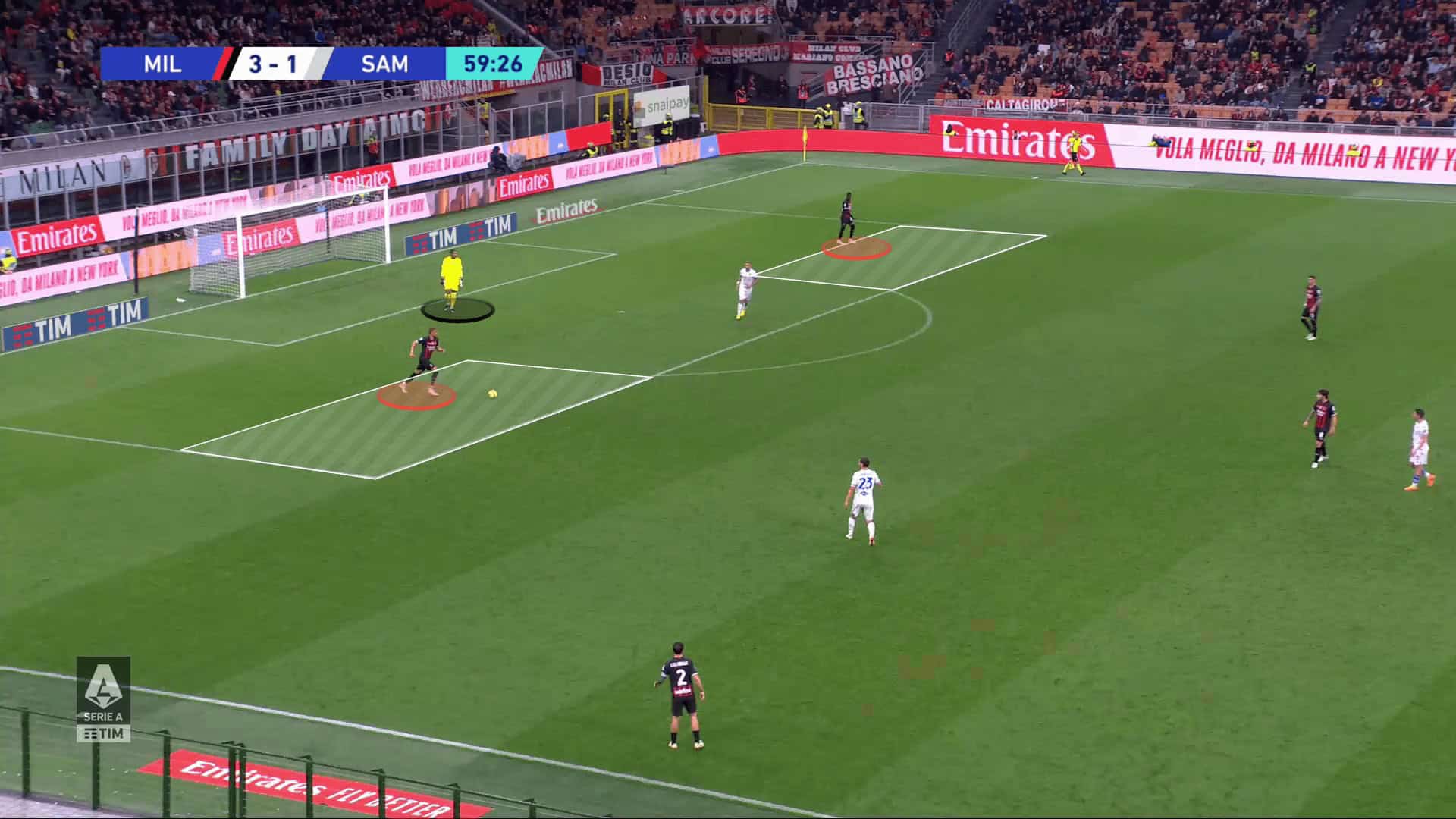
Defenders taking goal-kicks can also provide a tactical variation by changing the dynamics of the team’s build-up play. With a defender taking the kick, the goalkeeper can push higher up the field, becoming an extra outfield player and offering an additional passing option. This can help the team maintain possession and create more passing triangles, leading to better ball circulation and increased control of the game.
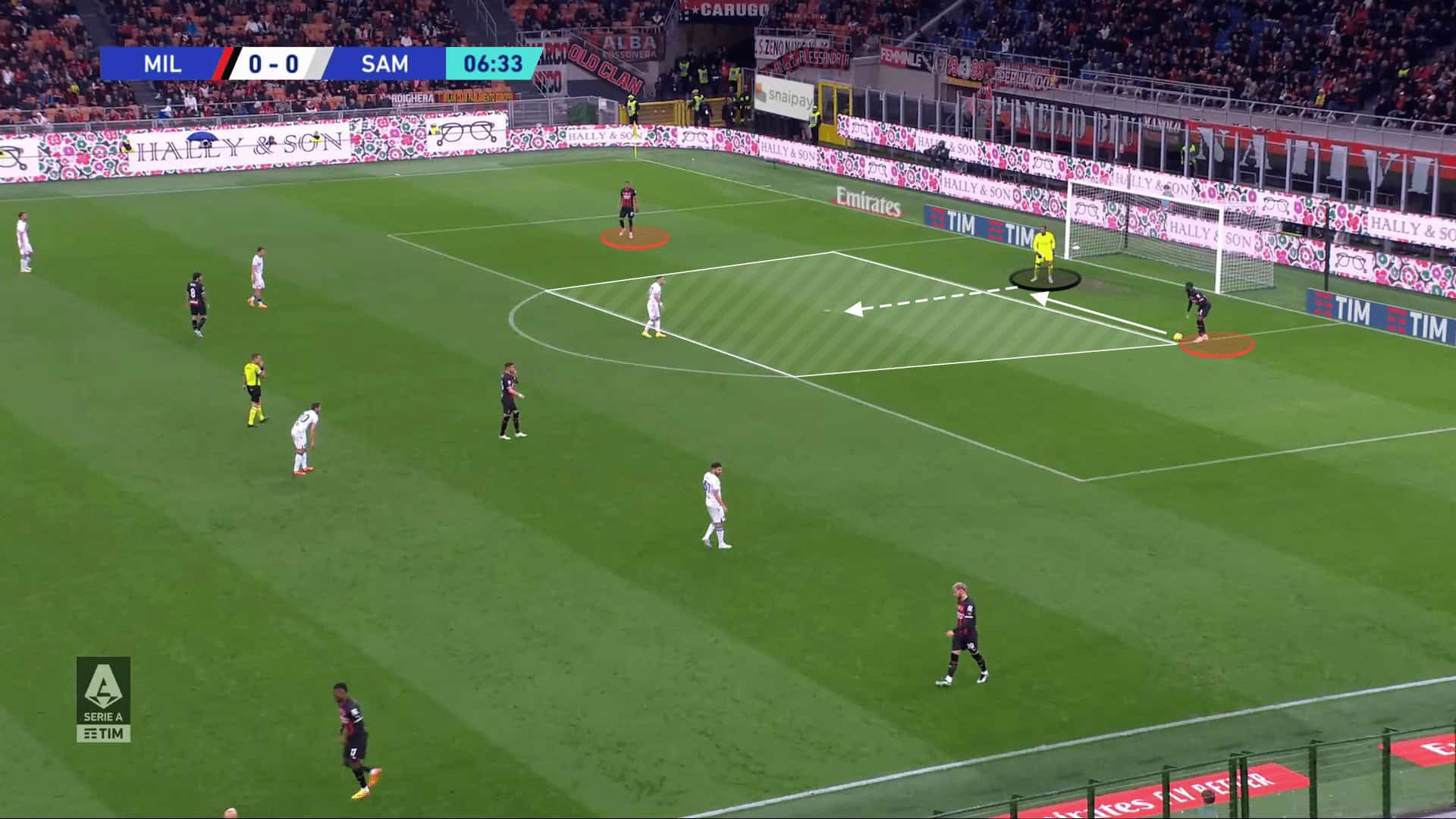
Moreover, defenders taking goal-kicks can surprise the opposition and disrupt their defensive structure. By distributing the ball from the backline, defenders can exploit spaces left unguarded by opponents who are anticipating the goalkeeper’s long kick. This can catch the opposition off guard, allowing the team to quickly transition from defence to attack and bypass the midfield congestion.
Another advantage of having defenders take goal-kicks is their familiarity with the defensive line’s positioning and movement. Defenders are often more adept at recognising gaps in the opposition’s defensive setup and can make accurate passes to exploit those spaces. This can be especially beneficial when the team wants to initiate a fast-paced attacking move.
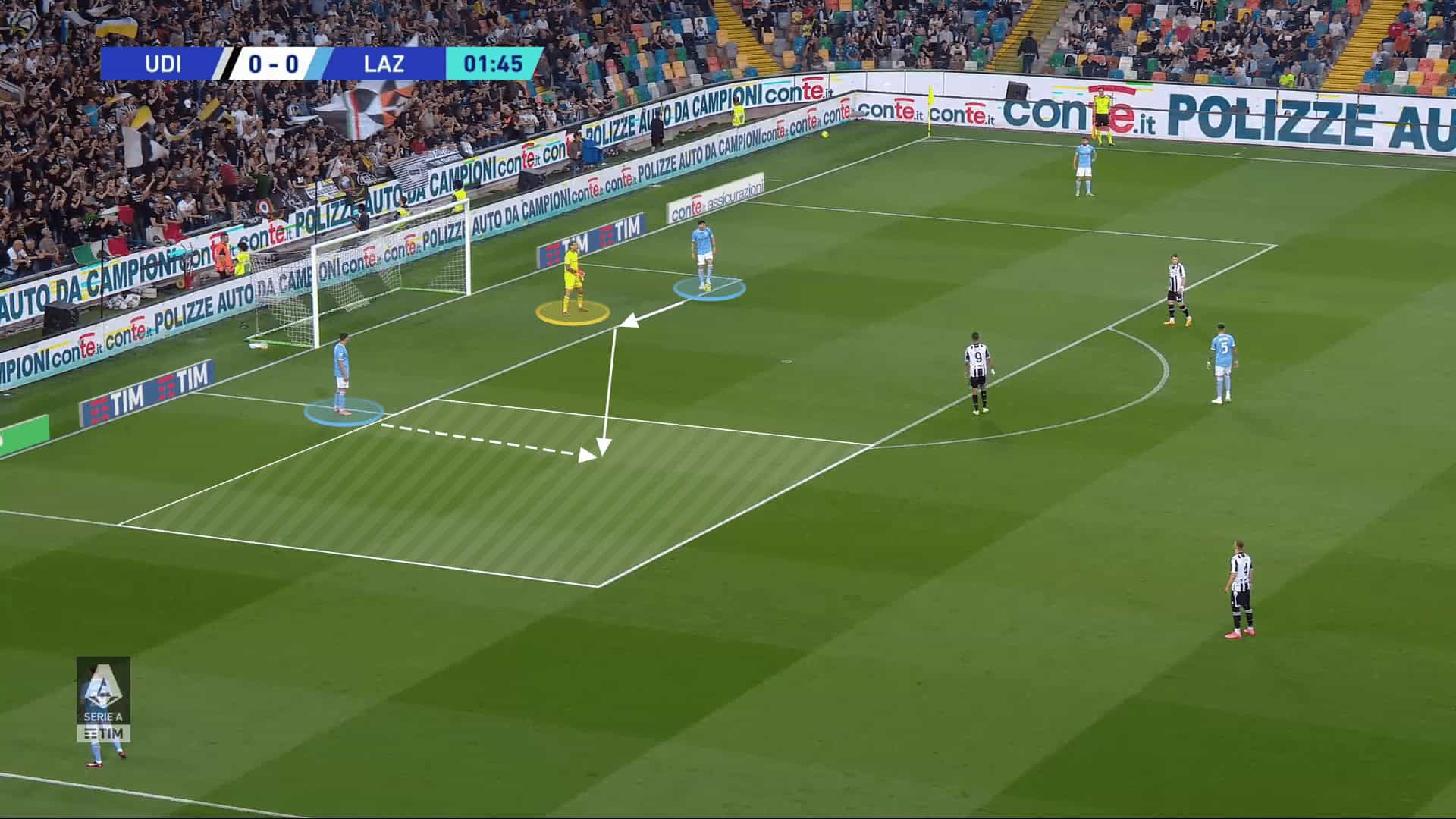
In terms of defensive positioning, having a defender take a goal-kick requires careful coordination. The rest of the defensive line must adjust accordingly to provide passing options and maintain defensive stability in case the opposing team presses aggressively. Communication and understanding among the defenders are crucial to ensure a smooth transition from the goal-kick to maintaining possession and avoiding turnovers.
Data Analysis
In the Italian Serie A, we witness a high number when it comes to defenders taking goal-kicks, according to the data. While the majority of teams in the world entrust this responsibility to their goalkeepers, there are notable exceptions where defenders step up to initiate play from the back.
Among the clubs leading this trend is Lazio, with an impressive tally of 106 goal-kicks taken by their defenders. This emphasises their desire to distribute the ball efficiently and maintain possession right from the outset. Following closely behind are Empoli with 101 and Spezia with 90 goal-kicks executed by their defenders, showcasing their commitment to building play from the defensive line.
On the other end of the spectrum, Salernitana stands out with just one goal-kick taken by defenders, indicating a preference for their goalkeeper to assume primary responsibility. Similarly, Roma and Napoli only recorded three instances of defenders taking goal-kicks, suggesting a more traditional approach.
The median value of 33 goal-kicks taken by defenders is noteworthy, coincidentally aligning with Atalanta’s own total. These statistics shed light on the varying strategies employed by Serie A clubs and highlight the significance of defenders’ involvement in the early stages of possession play.
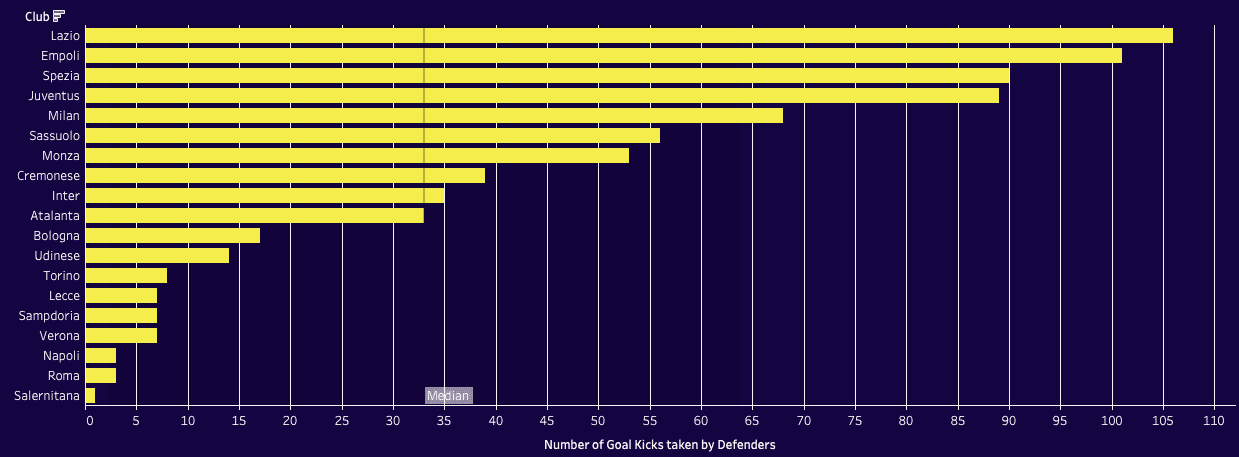
Among the defenders leading this charge is Sebastian Luperto, who tops the charts with an impressive 75 goal-kicks taken. His precise distribution and confidence on the ball have made him a valuable asset in his team’s possession-based approach. Following closely behind is Alessio Romagnoli with 64 goal-kicks, displaying his role as a key playmaker from the defensive line. AC Milan’s Fikayo Tomori also demonstrates his composure and passing ability by contributing 56 goal-kicks. On the other end of the spectrum, Ardian Ismajli, Ethan Ampadu, and Francesco Acerbi share the lowest number of goal-kicks taken by defenders, with each recording 15.
It is noteworthy that the median value for goal-kicks taken by defenders is 22, a figure comparable to the performance of Leonardo Bonucci, who has contributed 23 goal-kicks.
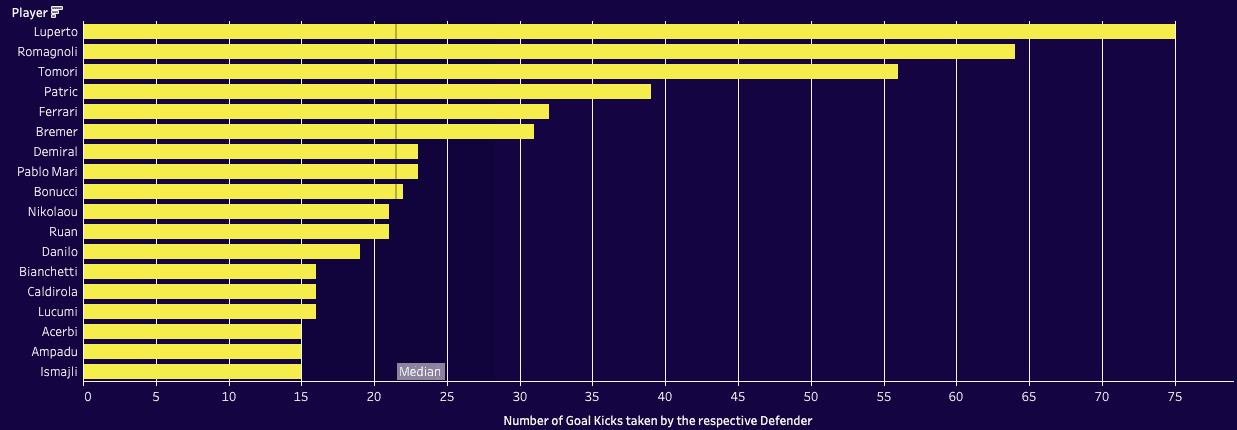
However, there are potential drawbacks to defenders taking goal-kicks as well. Defenders may not possess the same range and accuracy in their kicks as goalkeepers, which can limit the distance the ball travels and reduce the team’s ability to switch play quickly. Additionally, defenders may not be as comfortable under pressure as goalkeepers, potentially leading to misplaced passes or turnovers in dangerous areas.
When analyzing the importance of successful passes by centre-backs during goal-kicks, it becomes evident that their ability to accurately distribute the ball plays a crucial role in maintaining possession and initiating attacking moves. In the context of Italian Serie A clubs, it is noteworthy that defenders who take goal-kicks exhibit a high level of passing efficiency. In fact, none of the defenders in this role have a successful passing rate below 86%, highlighting their proficiency in executing precise passes. Only one exception can be found with the likes of Bianchetti, who maintains a still respectable passing rate of 82.4%.
Leading the pack in terms of passing accuracy is Alessio Romagnoli, who boasts an impressive success rate of 92.3%. This statistic underscores Romagnoli’s exceptional ball-playing skills and his ability to make accurate long-range passes to teammates, allowing his team to maintain possession and build attacks from the back. This emphasises the centre-backs’ crucial role as key contributors to the team’s overall possession-based style of play and the importance of their technical abilities in launching effective offensive movements.
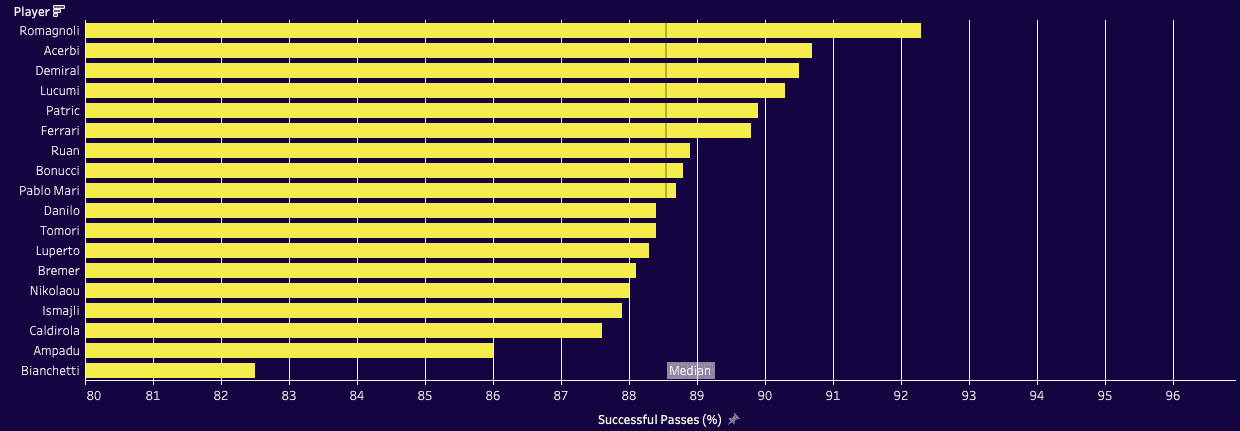
Serie A is leading
In Serie A, the trend of defenders taking goal-kicks more often than in other leagues can be attributed to several factors that are unique to the style and tactics of Italian football. One primary reason is the emphasis on ball possession and building attacks from the back, commonly known as “playing out from the back”. Italian teams have long embraced a possession-based playing philosophy that prioritises maintaining control of the ball and initiating attacks through controlled build-up play.
By having defenders take goal-kicks, teams in Serie A can ensure better ball circulation and maintain possession right from the start of an attacking move. Defenders are typically skilled in distributing the ball accurately and have a better understanding of their teammates’ positioning on the field. This enables them to make informed decisions about where to place the goal-kick, helping their team to gain an advantage in terms of retaining possession and initiating their offensive strategy.
Additionally, defenders in Serie A are often well-drilled in tactical systems that require precise passing and maintaining a structured playing style. Coaches and teams in Serie A place great importance on maintaining defensive organization and minimizing turnovers. By having defenders take goal-kicks, teams can ensure that the ball is played out with precision, reducing the risk of turnovers in dangerous areas.
Furthermore, the defensive quality in Serie A is renowned, with many teams employing strong defensive lines and utilising the expertise of their centre-backs in various aspects of the game. By involving the defenders in goal-kicks, teams can take advantage of their defensive abilities while also using their passing skills, creating a seamless transition from defensive to offensive play.
Conclusion
In conclusion, while not as common as goalkeepers taking goal-kicks, defenders assuming this responsibility can offer tactical advantages in football. They can exploit pressing tactics, add unpredictability to the team’s play, and provide different passing options. However, it is important to consider the individual qualities of the defender, the team’s playing style, and the coordination within the defensive line to optimise the benefits and mitigate potential drawbacks of defenders taking goal-kicks.
The increased frequency of defenders taking goal-kicks in Serie A can be attributed to the league’s focus on possession-based play, the technical abilities of the defenders, the emphasis on defensive organisation, and the desire to maintain control over the ball right from the start of attacking moves. These factors combine to create a tactical approach that maximises the effectiveness of defenders in playing a pivotal role in initiating and dictating the team’s attacking play.





Comments